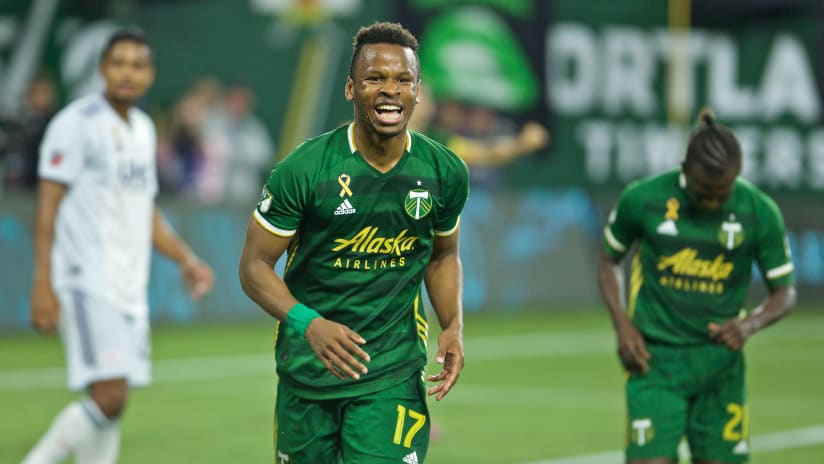Rostered forwards (in alphabetical order): Dairon Asprilla, Jeremy Ebobisse
Odds are, if you’ve heard or read any analyses of the Portland Timbers’ attacking options, you’re familiar with some similar, well-founded conclusions: Sebastián Blanco’s a valuable piece; Jeremy Ebobisse is showing continued progress and promise; and the long rumored, now official return of Diego Valeri would keep a key cog at Providence Park. There’s an obligatory coda to those observations, though: The team needs more options.
Team chief executive officer Merritt Paulson implied as much during a late-season appearance on Talk Timbers, one where he emphasized the Timbers intended to add two new attacking talents. Team president Gavin Wilkinson then echoed those needs in his end-of-season press conference, with the two going as far as to explicitly identify positions. The team needed to add another striker. The team needed to add another winger.
Last week’s news only underscored that need. Although the team was clear to emphasize the knee injury Ebobisse suffered on national team duty was “minor” (and every indication since has reinforced that notion), you could forgive Timbers fans for indulging a depressing hypothetical: What if the injury had been worse? Or, what if, just as out of the blue, Blanco suffered a significant setback? Do the Timbers have enough attacking depth to withstand such a blow?
- READ: Roster Check | Timbers Midfielders
- READ:Roster Check | Timbers Defenders
- READ: Roster Check | Timbers Goalkeepers
As of now, the answer is no, something that makes it even more important that the Timbers succeed in their Designated Player pursuits. Thanks to Valeri’s new deal, the team now has two open DP slots (ask Netflix - they know), and as the offseason has progressed, it’s becoming increasingly clear that Portland should invest both of those spots on attacking talent.
When you look at the depth chart above, though, are only two signings enough? Because although Blanco could be seen as forward depth, and Valeri’s role often takes tramples the line between attacking midfielder and forward, you can also use a more narrow definition of forward to see a depth chart of only two – the players who would, in most cases, be an option to start up top in the team’s usual, one-forward setup. Both Blanco and Valeri took turns as somewhat false nines last year, but as of now, the only players who have been in the starting XI when the team needs a striker are Dairon Asprilla and Ebobisse.
For most Timbers fans, filing Asprilla as a forward will feel a little off, mostly because the Colombian’s first three years in green and gold saw him exclusively deployed in wide roles. Since head coach Giovanni Savarese’s arrival two years ago, though, the now-27-year-old’s athleticism has increasingly been utilized through the middle. Even the times Asprilla began games on the right late last season would often see him rotate into a more central position, taking advantage of the versatility of Blanco and Ebobisse to give Portland a more fluid look.
Ebobisse, too, has added more positional versatility over the last two years, albeit with a different progression. Developed and drafted as a traditional forward, Ebobisse began playing in wider areas early in 2018, while still with Timbers 2. In 2019, the U.S. international was a regular playing on the wing, whether doing so to create room after Brian Fernandez’s arrival or playing his part in those fluid, three-forward looks. Whatever attacking options Portland adds this winter, Ebobisse will have multiple routes to maintaining his starting spot, with his goal scoring, holdup play and defensive value making him integral to the team’s approach.
Clearly, though, Portland needs to add to their forward options, and if recent history is any indication, they’ll want to create a true competition for the starting spot. Two years ago, that competition was between Samuel Armenteros and Fanendo Adi, both of whom made way for Ebobisse by year’s end. Last season, Portland broke preseason camp with Ebobisse and Lucas Melano and eventually added Fernandez. Even going back to the forward core of 2015 – a standard Wilkinson has evoked over the last two years – the eventual MLS Cup winners had both Adi and Maxi Urruti. If that dynamic is still Portland’s model, the Timbers will be adding somebody who can push their incumbents.
Beyond a traditional forward, the Timbers’ other big need is wide, even if players like Tomás Conechny, Marvin Loría, and Andy Polo provide some preexisting options. Still, when you look at the rest of the team’s roster – seeing the options Portland has in goal, along the back line, and in midfield – the obvious place to invest a Designated Player spot is wide. Polo has provided a certain level of stability during his two years in the Rose City, and Loría has given the organization every reason to be excited for his future, but if there’s one place where the Timbers can add a talent that can move them back up the Western Conference standings, it’s in a wide attacking role.
Add those two players, and remember players like Blanco, Conechny, Loría and, to a certain extent, Valeri can augment the team’s depth, and the Timbers’ forward corps will start to look healthier. But whereas our last roster check saw us examining a midfield teeming with options, Portland’s current forward group needs help. As if term “Designated Player” didn’t imply as much – and the need for two didn’t reinforce it – restocking in attack will be the Timbers’ most important task this offseason.












